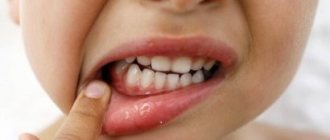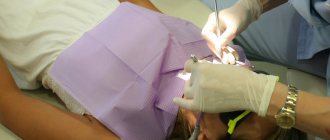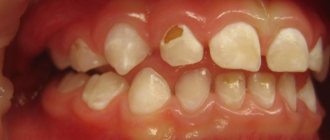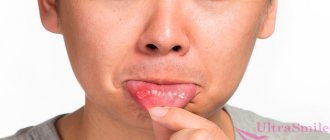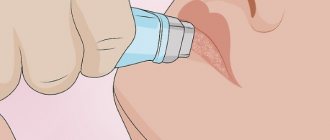July 28, 2020
Some parents, upon discovering a white dot on the gum of an infant or older child, immediately begin to panic. Taking care of your baby's health is the right thing to do, but a symptom is not always a threat. In any case, you first need to figure out what triggered the appearance of a spot, pimple or lump, and then act, but, of course, without unnecessary nerves and preferably by consulting a doctor. And journalists from the UltraSmile.ru portal will tell you about the main reasons why white spots might appear on your baby’s gums.
Reason No. 1. Epstein's pearls, or palatal cysts
White spots on a newborn's gums can be completely harmless if they are Epstein pearls. They are usually located on the upper jaw and palate. Outwardly they look like yellowish or white beads. Size – no more than 3 mm in diameter. They appear in 60–85% of newborns. They are nothing more than a cluster of epithelial cells. The formations are noticeable when yawning and opening the mouth. They do not cause babies any unpleasant sensations or discomfort, and 1–2 weeks after birth they go away on their own.
Epstein's pearls appear in 60–85% of newborns
“A white spot on a baby’s gum or spots that appear during the first days after birth are often caused by the accumulation of estrogen, a hormonal crisis and the body’s adaptation to new conditions. This phenomenon certainly requires careful monitoring, but does not require treatment and should not cause serious concern on the part of parents. If the baby develops normally, then during the first months of life the spots disappear on their own,” explains pediatrician A.V. Skromnova.
Teething
The first teeth can appear as early as 4-5 months.
Teething is a rather difficult period in the life of every baby. And it is the white spot on the child’s gum that is the main precursor to such an event as tooth eruption.
The timing of the appearance of teeth among children usually varies, but generally coincides with those indicated in the table:
| Name of teeth | Period of eruption | |
| Upper | 8-12 months |
| Lower | 6-10 months | |
| Upper | 9-13 months |
| Lower | 10-16 months | |
| Upper | 16-22 months |
| Lower | 17-23 months | |
| Upper | 13-19 months |
| Lower | 14-18 months | |
| Upper | 25-33 months |
| Lower | 23-31 months | |
Teething is usually accompanied by the following symptoms:
- swelling, redness of the gums;
- increased salivation;
- restless sleep;
- loss of appetite, refusal to eat;
- The baby puts various objects into his mouth.
Against the background of teething, pathological conditions such as fever, runny nose or upset stool often develop.
A white spot on the gum may be the precursor of a tooth.
But parents need to understand that teething is a normal physiological process, they just need to survive it, trying to alleviate the baby’s suffering as much as possible, paying him more attention and care.
Teethers for teeth.
For some children, the appearance of teeth causes only mild discomfort, while for others it is accompanied by severe pain. Based on this, you need to choose appropriate ways to alleviate the condition. If the baby tolerates the appearance of teeth quite calmly, then it will be enough to regularly offer him special teethers, as in the photo.
If the baby often cries, complaining of pain, then it is worth using special drugs that facilitate teething. The most popular of them are presented below.
Important: Before you start using any medicine to ease teething, you should always consult your doctor.
Reason No. 2. Bon's knots
White dots on the gums of a baby, as in the photo below, are Bon's nodules. A person who is not related to medicine is unlikely to be able to distinguish them from Epstein’s pearls outwardly, especially since they also consist of keratinized epithelium, but they take longer to disappear - within 3 months after birth. Benign and completely painless nodules got their name in honor of the famous German pediatrician who first described this phenomenon back in 1886.
Bohn's nodules consist of keratinized epithelium
Reason #3: Neonatal teeth
This is a very rare phenomenon (occurs in 1–2% of cases), but it still occurs. Neonatal, or congenital, teeth appear as white balls on a baby's gums. They may appear immediately or a month after birth. Most often they are localized on the lower jaw in the incisor area.
What does a neonatal tooth look like? The white hard point on the gum of a baby resembles a regular milk unit in appearance, but it is distinguished by mobility, since its roots are too short or absent.
A white hard spot or swelling on the gum of a child who is already 4-6 months old may indicate the imminent eruption of the first milk units. Usually during this period the baby becomes restless and may develop a cough and nasal discharge. If the formation on the gum has a bluish tint, and the tooth does not break out for a long time, then this situation may indicate an eruption cyst in which blood and fluid have accumulated. Contact a doctor who will cut the gum and help the milk unit come out quickly.
Doctors recognize the phenomenon as a deviation from the norm, which is random in nature. Less commonly, the appearance of neonatal and congenital teeth is associated with developmental defects. However, there is no rush to remove such elements, since as a result they are often included in a number of milk units, of which in total the baby erupts only 20 pieces.
This pathology is very rare
But sometimes neonatal teeth are supernumerary, interfere with the baby’s eating, cause pain for the mother when breastfeeding, and in these cases they are removed. An indication for removal can also be severe mobility of the unit, because if a tooth falls out on its own, it can lead to aspiration and respiratory arrest in the baby.
If the causative tooth is still a baby tooth -
When writing this section, we used the “National Guide to Pediatric Therapeutic Dentistry” (edited by Professor V.K. Leontyev). Let's figure out what parents need to know... The presence of a swelling/bump on the gum, or a fistula, indicates the development of acute periodontitis, or an exacerbation of chronic periodontitis. In the vast majority of cases, baby teeth that have caused the appearance of ulcers on the gums must be subject to mandatory removal. The fact is that in most cases the roots of baby teeth will either not yet be formed or will already have signs of resorption (see photo below).
In both cases, this will not allow for high-quality obturation (filling) of the root canal lumen with filling material. Poor quality filling will certainly lead to the development of purulent inflammation, and in severe cases, sepsis, which even poses a threat to life. Injury to the permanent tooth germ is also possible, both during root canal treatment and as a result of the development of purulent inflammation in the area of the apex of the roots of a baby tooth.
Milk teeth for removal (with signs of resorption) –
But the physiological immaturity of the immune system of children also poses a problem for the treatment of such teeth, which in this situation also contributes to the development of purulent complications. Therefore, to determine the possibility of treatment, we first need a targeted Rg image, which will show the degree of resorption, as well as the presence of foci of inflammation at the apex of the roots of a baby tooth. Below we will list when such teeth require mandatory removal, and in what situations you can try endodontic root canal treatment in baby teeth.
Indications for mandatory removal:
- if there are less than 2 years left before the physiological change,
- if the tooth crown is severely damaged and cannot be restored,
- the tooth has degree II-III mobility,
- in the presence of a fistula tract,
- if the x-ray shows signs of root resorption (we are talking not only about external root resorption, but also about internal one),
- if the image shows a pronounced inflammatory focus of bone tissue destruction (at the apex of the root of a baby tooth), i.e. we are talking about an exacerbation of chronic granulating periodontitis,
- if the child belongs to health groups III, IV, V,
- if the child has caries in the area of most teeth (decompensated form of the carious process).
Possibility of endodontic treatment:
- if the root of the baby tooth is formed and does not show signs of resorption,
- in the absence of tooth mobility,
- in the absence of a fistula tract,
- if the focus of inflammatory destruction at the apex of the root of a baby tooth is very small in size, and at the same time is separated from the permanent tooth germ by a layer of unchanged bone tissue. Filling the canals of a baby tooth (before and after photos) –
Important: you should also take into account that such treatment is very complex and requires a highly qualified pediatric dentist, as well as a large amount of time per patient. Therefore, this is unlikely to be a good idea – if we are talking about public medicine. Also, endodontic treatment will require several visits, and subsequently regular follow-up with radiography (parents must be prepared for this). You also need to consider how important this tooth is in terms of preventing malocclusion.
Filling canals in a baby tooth (video):
In the video below you can see the process of filling root canals in the 1st primary molar. Please note that mechanical treatment of root canals was performed using an endodontic tip and modern rotary files (created specifically for children's teeth). The most modern paste based on calcium hydroxide and iodoform was used as a material for filling root canals in baby teeth. At the end of the video, you will be able to see an x-ray that shows the quality of root canal filling. In this case, I would like to say about the excellent work of the doctor.
A few more things parents should know:
Unfortunately, in recent years, due to the deterioration in the quality of training of doctors, you can hear that many pediatric dentists recommend not removing such teeth, citing the fact that removal will cause malocclusion. And therefore, very often children continue to walk with chronic inflammation at the roots of their baby teeth. In part, the effect of early removal of baby teeth on the bite is true (but primarily only in relation to baby molars, the removal of which can lead to a shift in the rudiments of permanent teeth). But this is not the only thing to consider.
The fact is that the purulent focus of inflammation in the area of the roots of a baby tooth is separated from the permanent tooth germ by only 1-2 mm of bone (Fig. 6). Studies have shown that disruption of the eruption of permanent teeth is caused not only by the early removal of baby teeth, but also by the influence of pyogenic bacteria and their toxins on the rudiments of permanent teeth. For example, you did not remove a child’s baby tooth with inflammation at the apex of the root, and this will also delay the eruption of a permanent tooth. In addition, inflammation at the root of a baby tooth can even lead to the death of a permanent tooth germ (this happens especially often if inflammation occurs before the start of mineralization processes in the permanent tooth germ).
Important: you also need to take into account the effect of a pyogenic infection on the general health of the child. For example, the fact that infection from the source of inflammation will constantly enter the submandibular lymph nodes, causing the development of lymphadenitis. In addition, once in the blood, waste products of pyogenic bacteria affect the entire body as a whole - they increase the risk of developing allergies, bronchial asthma, diabetes, heart and joint diseases.
If purulent inflammation is accompanied by the formation of a fistula, then you must understand that pus will constantly enter the oral cavity through the fistula, the child will swallow it, and this will lead to the colonization of the tonsils with a pyogenic infection and the development of chronic tonsillitis. And in this case, the development of a sore throat or constant regular exacerbations of chronic tonsillitis is guaranteed for the child.
Reason No. 4. Stomatitis
Often, a white pimple on a baby’s gum, as in the photo, gives reason to suspect a disease such as stomatitis. An inflammatory process on the mucous membrane can appear in both very young children and older ones. The main causes of the pathology: weak or unformed immunity, poor oral hygiene, injuries, allergies, infection of wounds and scratches in the mouth with dirty hands and foreign objects.
White dots may indicate stomatitis
A white spot on a baby’s gum, covered with plaque, most often indicates candidal stomatitis (in 90% of cases) caused by the Candida fungus, but aphthous, traumatic, drug-induced or herpes stomatitis can also be to blame. A dentist or pediatrician can determine what type of disease your child has and prescribe the appropriate course of treatment.
Treatment of white spots on gums
The first thing parents need to do is visit a pediatrician. If necessary, the child will be referred to a dentist. Pediatric dentistry is a department where the factors that provoke the disease are determined. Depending on your age, the doctor will carry out therapeutic measures.
- In case of improper hygiene, the mother will receive professional recommendations.
- When pimples are a consequence of vitamin deficiency, the nutrition of the mother and child is adjusted. You should drink enough liquid.
- Congenital masticatory organs, if they are mobile, are removed.
- Pathological diseases are treated with modern methods.
- The toddler should be protected from anxiety and stress.
- Stomatitis is treated with antiseptics, for example, Miramistin. The drug is prescribed by a doctor.
- Candida fungus is eliminated with drugs such as Flucostat. The baby's mouth is treated with chlorhexidine.
- If there is a lack of calcium, the necessary minerals are prescribed.
You cannot puncture the blisters yourself. The gum tissue may be damaged. After all, with such a procedure, infection can easily occur.
Reason No. 5. Lack of oral hygiene
White spots on a baby's gums and plaque may simply be remnants of formula or breast milk that the baby was fed with. Or indicate that the baby recently burped. How can I check this? Take a special napkin, silicone brush or cotton sponge and wipe the palate, gums and mucous membranes.
It is important to remember that even the smallest children need hygienic oral care, since their diet contains sugar, and in the mouth, just like in adults, plaque and bacteria accumulate, which can provoke an infectious and inflammatory process.
Questions for the doctor
Stomatitis during teething
My son is 10 months old. And from the very first tooth, which appeared at 7 months, before teething, all his gums are covered with a white coating. The child is in great pain, his temperature often rises, and he refuses to eat. Doctors prescribed a lot of things, but only Candide drops help. What else can you try to get rid of candidiasis once and for all?
During teething, a significant decrease in local immunity occurs, which is why other pathological conditions often develop against the background of this process. In order to reduce the risk of recurrence of thrush in a child, you need to pay maximum attention to strengthening his immunity: good nutrition, frequent walks in the fresh air, drinking plenty of fluids and maintaining cool, moist indoor air.
White plaque during breastfeeding
Today I noticed a white coating on my child’s tongue. The baby is only 2 months old and is breastfed. The coating is only on the tongue, the palate, cheeks and gums are clean. I tried to clean off this deposit with gauze soaked in boiled water, and everything went away without a trace. How can you tell if it’s thrush or if you shouldn’t worry?
Most likely, your baby has plaque from breast milk. This is normal and does not require any treatment. If the plaque is easily and completely cleaned off, and the child behaves as usual and does not refuse food, then this is not candidiasis. Continue to monitor your child's oral health and take your child to your pediatrician if necessary.
Cholisal for a child up to one year old
My daughter is 9 months old and recently developed stomatitis. The doctor prescribed smearing the ulcers with Cholisal gel for pain relief, because they bother the child very much. But I read in the instructions that it should not be used on children under one year of age. What can replace this drug?
Cholisal gel has proven itself and is often used to alleviate stomatitis, including in children under one year of age. The instructions for this drug actually indicate that it can be used in children from 1 year of age. But as prescribed by a doctor and with caution, use in children under one year of age is also allowed. It is important not to use the drug in children of this age without a doctor’s prescription.
Reason No. 6. Advanced dental diseases
Of course, dental diseases in newborns are an exception. However, in children who have already acquired baby or permanent teeth, this is far from uncommon. If a child has a white dot on the gum next to the tooth as in the photo, then this may be associated with the development of periodontitis, periostitis (flux), fistula, cyst1 or abscess. These pathologies occur in cases where teeth with caries or pulpitis are not treated for a long time.
The photo shows a milk tooth cyst
Such white spots on the gums contain serous fluid or are filled with pus. They pose a serious danger to the child’s body and can lead to damage to the rudiments of permanent units, dysfunction of internal organs, blood poisoning and even death.
How to treat oral thrush in infants
Treatment of oral thrush in an infant is not a complicated process, but it requires the systematic implementation of certain procedures several times a day until the child recovers. If you find a mild degree of thrush in your baby, but at the moment you cannot call a doctor (for example, on a day off), then you can use traditional methods of eliminating thrush. If the degree of damage to the mucous membrane has already reached serious forms, it is better not to risk it and call an ambulance.
Traditional methods for eliminating thrush:
- using a soda solution: prepare a solution (dissolve 1 teaspoon of soda in a glass of warm boiled water), then wrap a sterile bandage around your finger, moisten the winding in the solution and very carefully wipe the areas of fungal infections; Do not rub them under any circumstances, because under the plaque there may be bleeding plaques, through which you risk allowing bacteria to enter the baby’s body; such light rubbing can be done 4 times a day until you have the opportunity to visit a doctor;
- use of honey solution: prepare a solution (dissolve 1 tsp honey in 2 tsp warm boiled water); however, please note that it is unacceptable to use a honey solution if a child is allergic to bee products; if the child tolerates honey well, then treatment with the solution can be carried out similarly to treatment with soda; You can also treat your baby’s pacifiers and toys, which he likes to put in his mouth, with any of these solutions;
- for candidiasis of the nipples, treat them with any of the above solutions;
- You can use other natural antiseptics for rinsing and treating the oral cavity - for example, herbal infusions; you can prepare a decoction of chamomile, green tea, calendula, taking 1 tsp. dry herbs for 1 cup of boiling water; Sage, elecampane, yarrow, burdock, and oak bark also have antiseptic properties, but it is also necessary to understand that any of the herbal preparations can cause an allergic reaction;
- sometimes the contents of aloe vera stems are used as antiseptics, lubricating the affected areas with this juice;
- Among the natural oils that can be used to lubricate the oral cavity, rosehip, flax or peach oils can be used after rinsing or treating plaque.
Reason No. 7. Wen, or lipoma
A white dot on the gum of a baby may indicate the accumulation of fatty tissue under the mucous membrane and the formation of a benign lipoma. The reasons for its appearance are varied: poor oral hygiene, trauma, past illnesses.
The neoplasm itself is not painful or dangerous, but after a long period of time it can greatly increase in size and begin to cause discomfort, be constantly injured, and even degenerate into cancer. If a baby has a wen, the doctor usually monitors its condition over time and, if necessary, may recommend removal using a laser or the traditional surgical method - with a scalpel.
A white dot on a baby's gum may be an accumulation of fatty tissue
Prevention
Prevention is important for healthy teeth and gums.
Childhood is the most vulnerable period in a person’s life, and it requires special attention, careful attitude and careful care from parents. Babies have a much greater risk of contracting any infection, so parents should be able to identify signs of standard teething and any pathological disorders, in which case they should definitely consult a doctor.
A lot in this matter depends on prevention. If parents pay enough attention to this point, then most likely, any gum disease will bypass the child.
Mandatory preventive measures include:
- proper and regular oral hygiene;
- keeping the child’s dishes and toys clean;
- complete healthy nutrition;
- timely treatment of any diseases;
- strengthening the immune system.
If parents nevertheless notice a dark spot or white dot on the child’s gum, then they should not try to self-medicate or use folk recipes. It is important to show the baby to a specialist as soon as possible, who can definitely determine whether this stain is dangerous or not, and will also tell you how to get rid of it.
What to do if a child has a lump, spot or dot on his gum
If you find a white spot on the gum of a baby, then you should not make a diagnosis yourself, relying on photos from the Internet, and, moreover, start self-medication. To begin with, it is recommended to thoroughly clean the mouth of a small child in order to get a good look at the growth and make sure that the problem is not caused by the accumulation of plaque and food debris. To do this, you need to use a soft silicone finger brush, specialized wipes or gauze soaked in warm water. To maintain hygiene, newborns should be given some water after each feeding.
The first step is to thoroughly clean your baby's mouth.
“If you have pimples and bumps in your mouth, run to the dentist, not to the pediatrician! Of course, there may not be anything dangerous at the points on the gums, but we have a not very pleasant situation. My daughter had a kind of pimple pop up next to a baby tooth, which looked healthy, and the pediatrician waved it off and said that it would go away on its own, but didn’t really explain anything. And the lack of intelligible explanations alarmed me, so I decided to go to the dentist. It turned out that the tooth was carious, but there was only destruction on the back side, and the pediatrician took a superficial look. I couldn’t even see it without a special mirror, normal lighting and tools! And in general, pediatricians have little education in matters of dentistry, they may not care, but your child will end up suffering!”
Gela, review from woman.ru
What if the problem is not caused by poor hygiene? Parents are advised to monitor the condition of the tumor and the well-being of the baby, and if serious pathologies are suspected and alarming symptoms appear (fever, moodiness, loss of appetite and sleep, bad breath, bleeding, etc.), they should consult a doctor. Only a specialist can make an accurate diagnosis and prescribe effective and safe treatment.
1Kushner A.N., Lapkovsky V.I., Petrovich N.I. Odontogenic cysts in children: epidemiology and treatment // Modern dentistry. – 2013.
Notice
: Undefined variable: post_id in
/home/c/ch75405/public_html/wp-content/themes/UltraSmile/single-item.php
on line
45 Notice
: Undefined variable: full in
/home/c/ch75405/public_html/wp-content /themes/UltraSmile/single-item.php
on line
46
Rate this article:
( 2 ratings, average: 5.00 out of 5)
gum disease
Candidiasis
Curdled coating with thrush.
The appearance of a white spot on a child’s gum, covered with a cheesy coating, may indicate an infection such as candidiasis or thrush. Its development is provoked by fungi of the genus Candida.
These are opportunistic microorganisms that, under special conditions, are capable of exhibiting their pathogenic activity and causing diseases of the mucous membranes of the oral cavity, intestines and genital organs.
Thrush causes pain and discomfort.
Like many other infectious diseases, candidiasis in a child’s body develops against the background of weakened immunity or insufficient hygiene in the baby.
The following can also trigger the development of thrush:
- difficult childbirth;
- infections acquired during childbirth;
- late attachment of the newborn to the mother's breast;
- artificial feeding;
- gastrointestinal disorders;
- taking medications;
- unfavorable environmental conditions.
When candidiasis appears in young children, it is important to consult a doctor promptly to prescribe adequate treatment. If you try to cope with it yourself and self-medicate, this can lead to serious complications, and sometimes even death if the fungus gets into the blood.
How does it manifest?
When the candidal plaque is removed, bleeding ulcers open.
When examining the oral cavity of a baby with candidiasis, you can see painful and itchy areas covered with a white cheesy coating on the gums, cheeks and palate. If this plaque is removed, a bleeding wound opens underneath.
Sometimes, with candidiasis, you can notice a dark spot on the child’s gum; in this case, the plaque is gray in color.
Other symptoms of thrush include:
- bad breath;
- bleeding gums;
- moodiness and restlessness;
- refusal to eat.
All of these symptoms may appear to varying degrees, depending on the stage and severity of the disease.
Treatment of candidiasis
Oral irrigation for thrush.
Successful treatment of thrush requires a whole range of measures that will help get rid of the fungal infection, increase local immunity and restore damaged mucous membranes. All points of this complex are equally important, so you need to follow them completely.
Namely:
- treating the oral cavity with a soda solution 3-6 times a day;
- applying antifungal drugs to the affected areas of the mucous membrane;
- vitamin therapy;
- the use of drugs that increase local immunity (Imudon, Lizobakt);
- exclusion from the diet of sour, salty, hot and rough foods.
Important: The acidic environment in the oral cavity stimulates the development of pathogenic microphora, including Candida fungi, so it is important to create a more alkaline environment.
Antifungal drugs that have proven themselves most effective in treating thrush are shown in the photo; their prices are approximately the same. But such medications can only be used after consulting a doctor, since each of these drugs has certain age restrictions and can cause adverse reactions.
Comments
My child has developed a white dot on his gum right next to his front baby tooth. The teeth are healthy, without holes, the child is 7 years old. What could it be?
Alexey (08/02/2020 at 00:22) Reply to comment
- Dear Alexey, perhaps your child’s permanent tooth has begun to erupt, and since the baby tooth has not yet fallen out, it simply does not have enough space and has changed the direction of growth. In this case, the baby tooth will have to be removed, otherwise there is a risk that the permanent tooth will move into the second row or will be severely curved, and the bite may be disrupted. Contact your pediatric dentist to clarify the situation and agree on a further plan of action.
Editorial staff of the portal UltraSmile.ru (08/04/2020 at 09:12) Reply to comment
I still don’t understand whether it is possible to independently treat a child if such a white spot occurs. After all, it usually goes away quickly when you spread it with brilliant green.
Alisa (08/21/2020 at 06:38) Reply to comment
Stomatitis will probably be treated in a baby with some safe ointments or pastes? Are such remedies completely safe for children or can they offer another method of treatment?
Olga (08/21/2020 at 08:56) Reply to comment
Hello, my child is 5 years old, the front tooth is much lighter than the rest, it is very noticeable (the rest of the teeth are normal white, but the front one is just snow-white.) Tell me, what is this connected with and what to do?
Vladimir (08/21/2020 at 08:58) Reply to comment
Recently we were talking to a girl on the playground and she said that her daughter often has stomatitis. I would like to know if this is contagious to other children? After all, they play with the same toys and can transmit bacteria through them.
Olga (08/21/2020 at 09:35) Reply to comment
Hello! Thanks for the useful article. After reading the article, I thought about it: my son had small dots right on his gums with a size of 0.5 mm, very small. I thought it was teething and didn’t pay much attention. The teeth are cutting through, everything is fine, thank God. I have a question: can such dots just appear before teething? Or should I also contact a pediatrician or dentist?
Kamila (08/21/2020 at 10:56 am) Reply to comment
My son has white spots on his gums and mucous membranes, has a slight fever, eats poorly, he is 1 year and 2 months old. It looks like stomatitis. Can I buy medicine for stomatitis at the pharmacy, or is it better to go to the dentist?
Olesya (08/21/2020 at 11:08 am) Reply to comment
Could white spots be an allergic reaction of the baby to spicy and salty foods in the diet of a nursing mother? The habit of generously salting and peppering food has been around for many years. For now, I’m trying to eat more neutral in taste, but sometimes I break down.
Alina (08/21/2020 at 11:26 am) Reply to comment
Why did my one-month-old baby start to have white spots on his gums, although this had never happened before? What measures would you recommend to take in this case and will these white dots harm the child?
Laima (09.23.2020 at 14:43) Reply to comment
How can white pimples on the gums and oral mucosa cause harm? These white spots have been formed for several weeks; what should the baby’s oral cavity be treated with to get rid of them?
Tanya (09.23.2020 at 14:45) Reply to comment
Tell me, can these white spots on the gums cause stomatitis in an infant? How to treat these white spots in a baby if the child is still breastfed?
Kira (09.23.2020 at 15:29) Reply to comment
The child suffers greatly due to the appearance of small white spots on the gums, as well as on the inside of the cheek. In appearance, these white dots look like leftover milk from a baby; they cannot be removed with a cotton swab; the child is constantly capricious. Please advise what can be done to rid the child of these white spots in the mouth?
Lyudmila (09.23.2020 at 15:41) Reply to comment
Write your comment Cancel reply
Symptoms of thrush in the mouth of a baby
What does thrush look like in a baby? When a fungal infection enters the child’s oral mucosa, its proliferation leads to inflammation in the mouth area. Therefore, quite quickly you will be able to notice small crumbs of white “cereal”, reminiscent of cottage cheese, on the child’s cheeks, palate, gums and tongue. An inexperienced mother may well assume that this is the remains of milk or formula after regurgitation. But checking whether this is so is quite simple: take dry sterile gauze or a bandage and very carefully try to remove the white coating. If these are really leftover food, they will be easily removed; if it is thrush, it will be more difficult to erase the curdled coating. And after removing it, you will notice inflamed redness in the oral cavity. If your baby has thrush, his appetite and sleep will most likely worsen, and he will become restless and moody.
